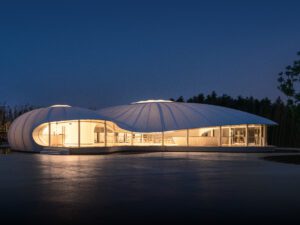“Nobody could call the square beautiful, exactly. Getting there used to require running the gauntlet of heavy traffic, and then finding oneself in a stockade ringed by fume-belching traffic,” wrote Deyan Sudjic in The Guardian (2003). The journalist was describing the state of London’s Trafalgar Square before its major redevelopment by British architect Norman Foster (b. 1935). Trafalgar Square encompasses a wealth of national landmarks, including Nelson’s Column; Canada House; the church of St Martin-in-the-Fields; the National Gallery; and South Africa House. Since the beginning of the 20th century, the square has seen an array of pivotal moments including women’s suffrage in the 1910s and demonstrations against US involvement in the Vietnam War in 1968. By the mid-1990s, however, the surrounding area had become heavily used by traffic, and the National Gallery’s façade was separated by a busy road. Foster’s much-needed upgrade in 2003 transformed Charles Barry’s (1795-1860) original 19th century design. It blocked cars from entering the north side, creating a new urban terrace and a more inviting setting for the iconic museum. Now, the area is described by Foster + Partners as “the result of a careful balancing act between the needs of traffic and pedestrians, the ceremonial and the everyday, the old and the new.”

This architectural project is just one of many to discover at Paris’ Centre Pompidou, which is hosting the biggest retrospective of Foster’s work to date, introducing 130 major proposals. The architect’s name is closely associated with high-tech buildings and sustainability. “The birth of the architect’s practice in the 1960s coincided with the first signs of an awareness of the fragility of the planet,” say Foster + Partners, who collaborated on the show. They’re keen to emphasise the importance of the architect’s creations: “These were the green shoots of what would later be named The Green Movement. These principles may now be mainstream but more than half a century ago they were revolutionary.“ Foster has long operated towards reducing carbon footprints, integrating pioneering strategies into his designs. One such example is the Reichstag (1988) in Berlin, where, underneath a transparent dome, you can find the main hall of the New German Parliament. It is “a manifesto of a green-powered building.” The glass cupola tracks the sun’s path and moves around at 360 degrees to block out solar glare. Furthermore, it produces electricity through an oil-burning system, which is cleaner than similar methods involving fossil fuels. The excess heat is stored and used for warmth. It has symbolic meaning, too, positioning the public above politicians.


On the BBC4 Podcast This Cultural Life, Foster explained that his practice is “rooted in an optimistic belief that design can significantly improve quality of life.” We see this play out in some of his most renowned spaces, like the British Museum’s renovated Great Court (2000). The premise was to implement an “urban glue”: a central space that connects various areas together. It is a user-friendly environment, a logical shortcut which lowers distances and simplifies the structure. Many of his other London-based constructions create a similar effect, and have become landmarks. The Millennium Bridge (2000), for instance, shortens the distance between St. Paul’s Cathedral and Tate Modern on South Bank. The steel suspension consists of two Y-shaped armatures that are supported by eight cables on both sides. Elsewhere, 30 St Mary Axe (2004) is mostly recognised for its significant look. Known affectionately by the public as “The Gherkin”, the a curved skyscraper towers above London’s design district, shining with geometric glass panels. Since its completion, it has become a notable feature of the skyline.

Centre Pompidou’s display explores six decades of international constructions spread across the globe including the Apple Park in Cupertino, USA (2018); the Hong Kong International Airport (1998); and the Viaduct in Millau, France (2004). These schemes feature overarching themes of movement and technical improvement, and are positioned alongside artworks by Ai Weiwei, Constantin Brancusi, Fernand Léger and Umberto Boccioni – Foster’s personal inspirations. Besides drawings, dioramas, models, sketches and videos, viewers can explore the architect’s vision through a special display of personal photographs.
Centre Pompidou | Until 7 August
Words: Fruzsina Vida
Image credits:
1. Trafalgar Square (2003), Nigel Young / Foster + Partners
2. Great Court, British Museum (2000), Nigel Young / Foster + Partners
3. Millau Viaduct (2004), Daniel Jamme / Eiffage
4. Millennium Bridge (2000), Nigel Young / Foster + Partners
5. 30 St Mary Axe (1999), Nigel Young / Foster + Partners





